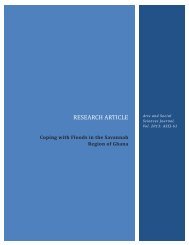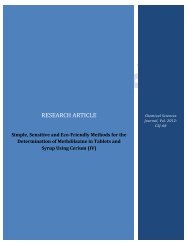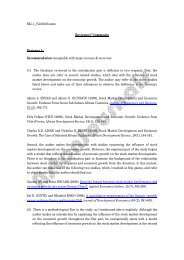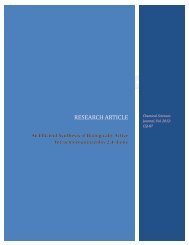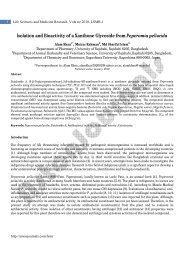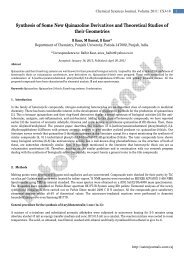Polyester Polyol Derived From Waste Poly - AstonJournals
Polyester Polyol Derived From Waste Poly - AstonJournals
Polyester Polyol Derived From Waste Poly - AstonJournals
Create successful ePaper yourself
Turn your PDF publications into a flip-book with our unique Google optimized e-Paper software.
Chemical Sciences Journal, Vol. 2012: CSJ-7632.1.1 Glycolysis of PET soft drink bottlesPET waste were glycolyzed using PPG (molecular weight 2000) in a three-necked glass reaction kettle equippedwith stirrer, condenser. Zinc acetate (0.5%) was used as a catalyst. The content of the reaction kettle washeated at 180 ◦ C for 1 h; subsequently the temperature was raised to 210 ◦ C until all the solids disappeared. Thereaction mixture was cooled and the products obtained were trans-esterified with Castor/Jatropha oil. Table 1shows the various compositions of PET and PPG taken for glycolysis.Table 1: Weight of PPG taken with PEG of various weights.Molecular Weight of PPG Weight of PET Zinc Acetate (g)2000 5% 0.5%2000 10% 0.5%2.1.2 Trans-esterificationTrans-esterification of glycolyzed oligoesters was carried out using Castor/Jatropha oil with a weight ratio of1:10. DBTDL (Dibutyltin Dilaurate) (2 wt %) was used as a catalyst. In a typical process of trans-esterification,required amounts of glycolyzed oligoesters, Castor/Jatropha oil and catalyst were charged in a three-neckedreaction kettle equipped with stirrer, vacuum line.The reaction mixture was heated at 80 ◦ C without vacuum for half an hour; the temperature was thenraised to 150 ◦ C with a vacuum of 125mmHg. The conditions were maintained for 1.5 h. The by-product formedwas continuously removed by vacuum. After the completion of the reaction, the mass was cooled to roomtemperature and brought to atmospheric pressure slowly. The polyester polyols thus obtained werecharacterized using Fourier transform infrared (FTIR) spectroscopy.2.2 Formulation of coating systemsTwo-pack coating systems were formulated using the polyester polyols as base component and melamineformaldehyde as curing agent. The components were mixed in the weight ratio of 1:1. The thoroughly mixedcompositions were coated on mild steel panels, using a bar applicator. The panels were placed in an oven at120 ◦ C for 30 min. These panels were used to evaluate various performances.2.3 FTIR spectroscopyGlycolysis of PET waste and the formation of polyester polyols were confirmed using FTIR spectroscopy. FTIRspectra were recorded as a film on a KBr cell using a Perkin Elmer Spectrum BX instrument.2.4 Panel preparationMild steel panels (2”x 3”) were prepared, prior to application of coating, as follows. First, panels were handscrubbed using a maroon scotch-briteR with 10% solution of Brulin 815 GDR detergent in DI water and thenrinsed with DI water. They were then immersed in 10% solution of Brulin 815 GDR detergent in DI water atminimum 142 F, followed by washing with DI water. Then the panels were deoxidized for 2 min in phosphoricacid-based deoxidizing solution, followed by DI water rinse and drying, and were then stacked for 24 h beforebeing used for application. Before coating application all the panels were washed with DI water for removal ofany loose dirt on the surface.2.5 Performance properties evaluationSaturated polyester polyol-based coatings were applied on mild steel panels for various tests. These includeMEK double rub test, pencil hardness test, chemical and solvent resistance test and corrosion resistanceperformance test (EIS).2.5.1 MEK double-rub testThe MEK solvent-rub test is a well-known and frequently used test throughout the coating industry. Its primaryutility to determine the extent, to which a coating is cured when interpreted properly, can be a very usefultool. The test itself is simple a cotton ball or rag is soaked in MEK and rubbed over the surface of coating agiven number of times. The effect on the surface is then evaluated in terms of gloss loss, softening, or degreeof rub off. The result of this type of test provides a measure of the chemical resistance of a given coating.When the results are compared to those of a control, known to be fully cured, a good qualitativedetermination of the degree of can be made.http://astonjournals.com/csj


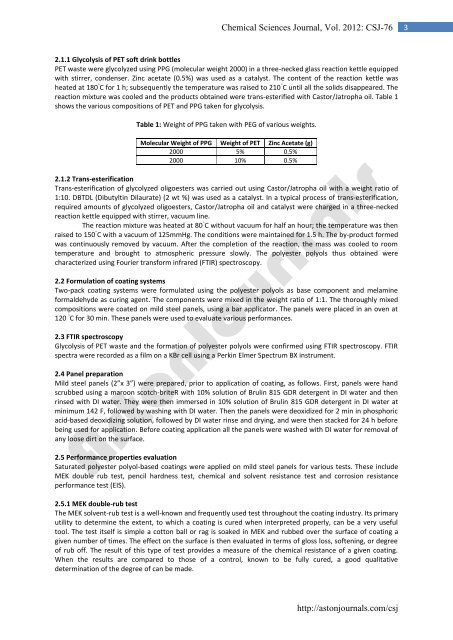
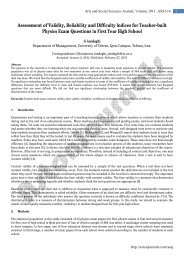
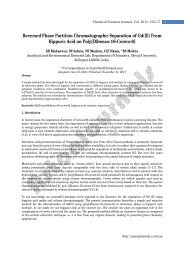
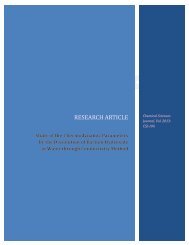
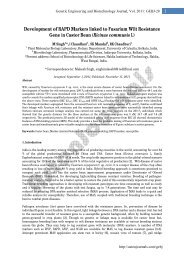

![[1,4]-benzodiazepine-2-one Derivatives as Potent - AstonJournals](https://img.yumpu.com/49117784/1/184x260/14-benzodiazepine-2-one-derivatives-as-potent-astonjournals.jpg?quality=85)
